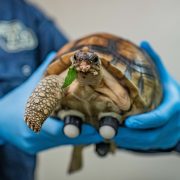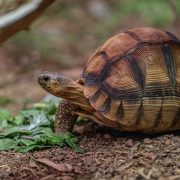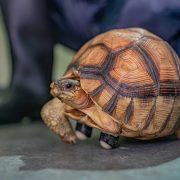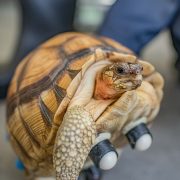An extremely rare, three-legged ploughshare tortoise has been rescued from wildlife smugglers and given a new home here at the zoo.
Hope was seized from illegal smugglers in Hong Kong, when it was discovered he was missing a leg. Experts have fitted a unique set of modifications to help him get around, and now he will play a key role in vital conservation efforts to save this ultra rare species.
Ploughshare tortoises are one of the world’s rarest animals with fewer than 300 remaining in the wild! He was rescued by customs officials from an illegal wildlife trader who was found with a suitcase concealing 57 live and endangered tortoises when travelling from the Comoro Islands off the coast of East Africa in 2019.
The illegal trafficker was subsequently jailed for two years, the heaviest penalty ever imposed under Hong Kong’s animal protection laws at the time.
Hope was immediately transferred into the care of conservationists at Kadoorie Farm and Botanic Garden Wild Animal Rescue Centre in Hong Kong, where he was found to be missing his front left leg, as well as claws on his hind left leg. This could possibly be due to a birth defect or injuries picked up when very young. Experts set about fitting three support rollers under his lower shell to help him to walk and balance.
Since his arrival at the zoo, our vets have made further modifications to the wheels to ensure his mobility support is perfectly optimised to help him get around his new surroundings.
Our conservationists have affectionately nicknamed the tortoise ‘Hope’ and say he’ll eventually join an important European conservation-breeding programme, which is playing a vital role in saving the critically endangered species from extinction.
“Ploughshare tortoises are exceptionally rare. It’s not just the world’s most threatened species of tortoise – it’s one of the most threatened animals on the planet!”
Dr Gerardo Garcia, Curator of Lower Vertebrates and Invertebrates.
Gerardo continued to say…
“Hope is settling nicely into his new home, and his prosthetic works so well that he moves even quicker than his three neighbours! Once he’s more developed, he’ll go on to produce offspring and contribute to the survival of the species thanks to the vital insurance population in conservation zoos.”
In the wild, the ploughshare tortoise can only be found on a small, remote stretch of sand, rock and bamboo on the island of Madagascar.
The species is listed under the highest protection category of the Convention on International Trade in Endangered Species (CITIES), prohibiting all forms of international commercial trade. It’s listed as critically endangered by the International Union for the Conservation of Nature (IUCN) having been poached to the very brink of extinction.
Just 63 ploughshare tortoises exist legally outside of Madagascar, as part of vital conservation breeding programmes battling to save the species. Our zoo is now home to four of these amazing animals.
Our scientists are using 24-hour CCTV cameras to monitor the tortoises and analyse their behaviour to learn more about the species. Kat Finch, a Conservation Scientist at the zoo, explains more:
“Our special cameras enable us to get an around-the-clock insight into the behaviour of the tortoises for the very first time. This data may help us to further improve their care and ensure we’re providing the best possible conditions to help them thrive. With so few ploughshare tortoises remaining on the planet, every single birth could be absolutely crucial to their survival.”
Highly prized for their distinctive gold and black shells, they fetch exceptionally high prices on the illegal, international black market – a result of their ever increasing rarity.
The illegal wildlife trade is worth £14 billion a year and is the fourth largest international crime after drugs, arms and human trafficking.
Mike Jordan, our Director of Animals and Plants, added:
“The ploughshare tortoise is a species that’s sadly under huge pressure for its survival and there’s a very real possibility that this species could be lost forever. That’s why Hope is such an important addition to the zoo. We refuse to sit back and see this incredible species disappear and so our aim now is to maintain an ark population, by coming together with some of the world’s other leading conservation zoos to breed a genetically viable safety net population and prevent its extinction.”



